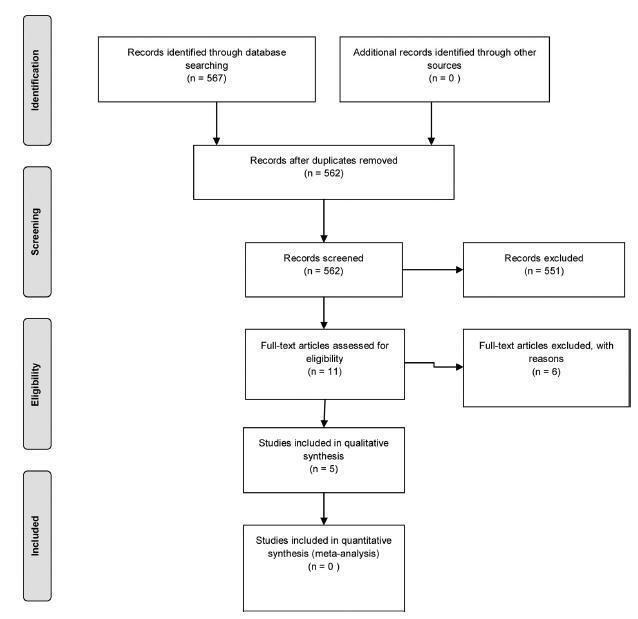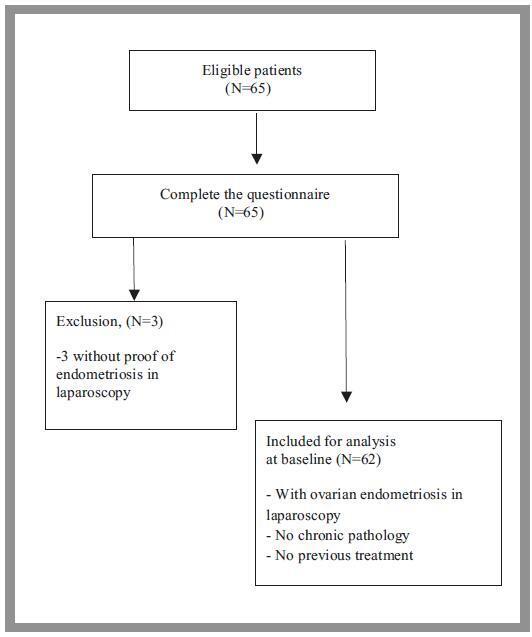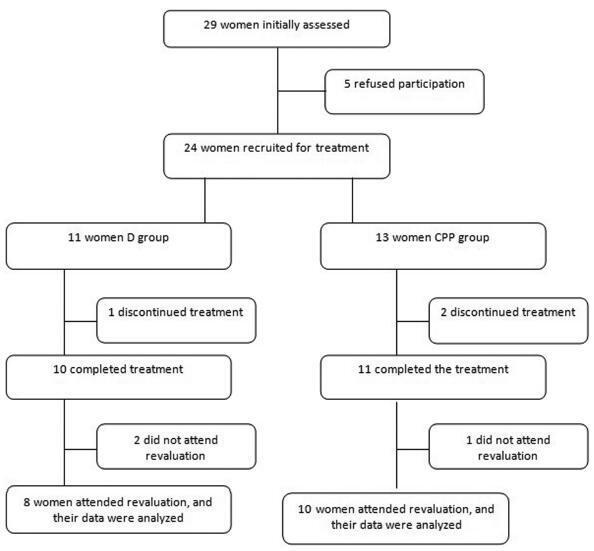-
Original Article06-27-2024
The impact of surgical treatment for deep endometriosis: metabolic profile, quality of life and psychological aspects
Revista Brasileira de Ginecologia e Obstetrícia. 2024;46:e-rbgo42
Abstract
Original ArticleThe impact of surgical treatment for deep endometriosis: metabolic profile, quality of life and psychological aspects
Revista Brasileira de Ginecologia e Obstetrícia. 2024;46:e-rbgo42
Views238Abstract
Objective
To evaluate the effects of surgical treatment of deep endometriosis on the metabolic profile, quality of life and psychological aspects.
Methods
Prospective observational study, carried out with women of reproductive age diagnosed with deep endometriosis, treated in a specialized outpatient clinic, from October/2020 to September/2022, at a University Hospital in Fortaleza - Brazil. Standardized questionnaires were applied to collect data on quality of life and mental health, in addition to laboratory tests to evaluate dyslipidemia and dysglycemia, at two moments, preoperatively and six months after surgery. The results were presented using tables, averages and percentages.
Results
Thirty women with an average age of 38.5 years were evaluated. Seven quality of life domains showed improved scores: pain, control and impotence, well-being, social support, self-image, work life and sexual relations after surgery (ES ≥ 0.80). There was an improvement in mental health status with a significant reduction in anxiety and depression postoperatively. With the metabolic profile, all average levels were lower after surgery: total cholesterol 8.2% lower, LDL 12.8% lower, triglycerides 10.9% lower, and fasting blood glucose 7.3% lower (p < 0.001).
Conclusion
Surgical treatment of deep endometriosis improved the quality of life and psychological aspects of patients. The lipid profile of patients after laparoscopy was favorable when compared to the preoperative lipid profile.
Key-words AnxietyDepressionEndometriosisInflammationLaparoscopyLipidsMental healthPelvic painQuality of lifesurveys and questionnairesSee more -
Original Article06-03-2024
Sexual function in women with endometriosis and pelvic floor myofascial pain syndrome
Revista Brasileira de Ginecologia e Obstetrícia. 2024;46:e-rbgo40
Abstract
Original ArticleSexual function in women with endometriosis and pelvic floor myofascial pain syndrome
Revista Brasileira de Ginecologia e Obstetrícia. 2024;46:e-rbgo40
Views224Abstract
Objective:
To evaluate and compare the sexual function and pelvic floor muscles (PFM) function of women with endometriosis and chronic pelvic pain (CPP) with and without Myofascial Pelvic Pain Syndrome (MPPS).
Methods:
Cross-sectional study conducted between January 2018 and December 2020. Women with deep endometriosis underwent assessments for trigger points (TP) and PFM function using the PERFECT scale. Electromyographic activity (EMG) and sexual function through Female Sexual Function Index (FSFI) were assessed. Statistical analyses included chi-square and Mann-Whitney tests.
Results:
There were 46 women. 47% had increased muscle tone and 67% related TP in levator ani muscle (LAM). Weakness in PFM, with P≤2 was noted in 82% and P≥3 in only 17%. Incomplete relaxation of PFM presented in 30%. EMG results were resting 6.0, maximal voluntary isometric contraction (MVIC) 61.9 and Endurance 14.2; FSFI mean total score 24.7. We observed an association between increased muscle tone (P<.001), difficulty in relaxation (P=.019), and lower Endurance on EMG (P=.04) in women with TP in LAM. Participants with TP presented lower total FSFI score (P=.02). TP in the right OIM presented increased muscle tone (P=.01). TP in the left OIM presented lower values to function of PFM by PERFECT (P=.005), and in MVIC (P=.03) on EMG.
Conclusion:
Trigger points (TP) in pelvic floor muscles (PFM) and obturator internus muscle (OIM) correlates with poorer PFM and sexual function, particularly in left OIM TP cases. Endometriosis and chronic pelvic pain raise muscle tone, weaken muscles, hinder relaxation, elevate resting electrical activity, lower maximum voluntary isometric contraction, and reduce PFM endurance.
Key-words EndometriosisMuscle tonusMyofascial pain syndromesPelvic floorPelvic painsexual satisfactionTrigger pointsSee more -
Original Article12-11-2023
Adaptation and Validation of the International Pelvic Pain Society’s Quality of Life Questionnaire in Portuguese
Revista Brasileira de Ginecologia e Obstetrícia. 2023;45(10):575-583
Abstract
Original ArticleAdaptation and Validation of the International Pelvic Pain Society’s Quality of Life Questionnaire in Portuguese
Revista Brasileira de Ginecologia e Obstetrícia. 2023;45(10):575-583
Views202Abstract
Objective
In the present study, our aim was to translate, adapt, and validate the Pelvic Health History Form (a quality of life [QoL] questionnaire) of the International Pelvic Pain Society (IPPS) from English to Portuguese.
Methods
The study was approved by the Ethics and Research Committee (CEP, in the Portuguese acronym) and the IPPS. The "Transcultural Adaptation" method comprised 5 stages: translation, synthesis, backtranslation, expert review, and pretest. Cultural adaptation and validation included cognitive interviews and statistical analysis of unanswered items (> 15%) in 14 clinic patients from CPP and endometriosis clinic at Santa Casa de São Paulo.
Results
Strong equivalences were established between the USA and Brazil questionnaires in terms of semantics, idioms, experiences, and concepts. Eighteen culturally inappropriate items were identified and adjusted using the revised response rate index. The subjective form underwent rigorous assessments, confirming its accurate measurement of intended targets.
Conclusion
The methodology showed efficiency and equivalence, confirming its validity. The user-friendly format and inclusion of translated, adapted, and validated instruments in Portuguese make the form valuable for evaluating pelvic health, with potential for future research.
Key-words Chronic painPelvic painQuality of lifesurveys and questionnairestranslationvalidation studySee more
-
Original Article04-17-2020
Quality of Life in Women with Deep Endometriosis: A Cross-Sectional Study
Revista Brasileira de Ginecologia e Obstetrícia. 2020;42(2):90-95
Abstract
Original ArticleQuality of Life in Women with Deep Endometriosis: A Cross-Sectional Study
Revista Brasileira de Ginecologia e Obstetrícia. 2020;42(2):90-95
Views187See moreAbstract
Objective
To describe clinical and sociodemographic characteristics of women with deep infiltrating endometriosis (DIE) and assess their quality of life (QOL) during 6 months of medical treatment.
Methods
A descriptive cross-sectional study of 60 women diagnosed with DIE either by surgery or image methods (ultrasound or magnetic resonance), who received clinical treatment for at least 6 months in the Universidade de Campinas, Campinas, state of São Paulo, Brazil. Both the SF-36 and the EHP-30 questionnaires were used to assess the quality of life.
Results
The mean age of the patients was 37.7 ± 6.0 years old, with 50% presenting dysmenorrhea; 57% dyspareunia; and 50% chronic pelvic pain. The SF-36 and the EHP-30 revealed impaired quality of life. In the SF-36, the worst domains were limitation due to emotional aspects (40.2 ± 43.1) and self-esteem and disposition (46.1 ± 24.8), whereas in the EHP-30 they were social well-being (50.3 ± 30.6); infertility (48.0 ± 36.3); and sexual intercourse (54.0 ± 32.1).
Conclusion
Although clinically treated, women with deep endometriosis present impairment in different domains of quality of life regardless of the questionnaire used for evaluation.
-
Review Article09-30-2019
Pharmacological Treatment for Symptomatic Adenomyosis: A Systematic Review
Revista Brasileira de Ginecologia e Obstetrícia. 2019;41(9):564-574
Abstract
Review ArticlePharmacological Treatment for Symptomatic Adenomyosis: A Systematic Review
Revista Brasileira de Ginecologia e Obstetrícia. 2019;41(9):564-574
Views206See moreAbstract
Objective
To assess the efficacy of non-surgical treatment for adenomyosis.
Data Sources
A search was performed by two authors in the Pubmed, Scopus, and Scielo databases and in the grey literature from inception to March 2018, with no language restriction.
Selection of Studies
We have included prospective randomized studies for treating symptomaticwomen with adenomyosis (abnormal uterine bleeding and/or pelvic pain) diagnosed by ultrasound or magnetic resonance imaging.
Data Collection
Studies were primarily selected by title and abstract. The articles that were eligible for inclusion were evaluated in their entirety, and their data was extracted for further processing and analysis.
Data Synthesis
From567retrieved records only 5 remained for analysis. The intervention groups were: levonorgestrel intrauterine system (LNG-IUS)(n= 2), dienogest (n= 2), and letrozole (n= 1). Levonorgestrel intrauterine system was effective to control bleeding when compared to hysterectomy or combined oral contraceptives (COCs). One study assessed chronic pelvic pain and reported that LNG-IUS was superior to COC to reduce symptoms. Regarding dienogest, it was efficient to reduce pelvic pain when compared to placebo or goserelin, but less effective to control bleeding than gonadotropin-releasing hormone (GnRH) analog. Letrozolewas as efficient asGnRHanalog to relieve dysmenorrhea and dyspareunia, but not for chronic pelvic pain. Reduction of uterine volumewas seen with aromatase inhibitors, GnRH analog, and LGN-IUD.
Conclusion
Levonorgestrel intrauterine system and dienogest have significantly improved the control of bleeding and pelvic pain, respectively, in women with adenomyosis. However, there is insufficient data from the retrieved studies to endorse eachmedication for this disease. Further randomized control tests (RCTs) are needed to address pharmacological treatment of adenomyosis.

-
Original Article09-30-2019
Quality of Life Assessment by the Endometriosis Health Profile (EHP-30) Questionnaire Prior to Treatment for Ovarian Endometriosis in Brazilian Women
Revista Brasileira de Ginecologia e Obstetrícia. 2019;41(9):548-554
Abstract
Original ArticleQuality of Life Assessment by the Endometriosis Health Profile (EHP-30) Questionnaire Prior to Treatment for Ovarian Endometriosis in Brazilian Women
Revista Brasileira de Ginecologia e Obstetrícia. 2019;41(9):548-554
Views190See moreAbstract
Objective
To evaluate the existence of an association between ultrasound findings and epidemiological and clinical factors using results obtained from the EHP-30 questionnaire in women with ovarian endometriosis.
Methods
A cross-sectional observational study was performed between July 2012 and May 2015, in which patients with chronic pelvic pain suggestive of endometrioma, as indicated by the results from a transvaginal pelvic ultrasonography, completed the standardized Endometriosis Health Profile - 30 (EHP-30) questionnaire to access quality-of-life scores before beginning treatment for endometriosis. A total of 65 patients were included. The data was analyzed in the statistical program IBM SPSS Statistics for Windows, Version 22.0 (IBM Corp., Armonk, NY, USA) for the comparison of data through linear multiple regression.
Results
The suitability of the linear regression model was confirmed by the histogram of the dependent variable and the residue distribution plot, confirming the trend of linearity as well as the homogeneous dispersion of the residues. The mean age of the patients was 39.7 ± 7.1 years old. Themajority was Caucasian (64.5%), had completed higher education (56.5%) and was nulligravida (40.3%). Infertility was present in 48.4% of the patients studied. Out of the total sample, 80.6% of the cases were symptomatic and complained mainly of acyclic pain, 79% of dysmenorrhea, and 61.3% of dyspareunia. This reflects the negative influence of endometriosis on the quality of life of patients with this disease.
Conclusion
Dyspareunia and acyclic pain were independent factors of correlation with high scores in the EHP-30 questionnaire, reflecting a worse quality of life.

-
Original Article08-01-2017
Evaluation of Cases of Abdominal Wall Endometriosis at Universidade Estadual de Campinas in a period of 10 Years
Revista Brasileira de Ginecologia e Obstetrícia. 2017;39(8):403-407
Abstract
Original ArticleEvaluation of Cases of Abdominal Wall Endometriosis at Universidade Estadual de Campinas in a period of 10 Years
Revista Brasileira de Ginecologia e Obstetrícia. 2017;39(8):403-407
Views140See moreAbstract
Purpose
To determine the clinical and epidemiological characteristics of abdominal wall endometriosis (AWE), as well as the rate and recurrence factors for the disease.
Methods
A retrospective study of 52 women with AWE was performed at Universidade Estadual de Campinas from 2004 to 2014. Of the 231 surgeries performed for the diagnosis of endometriosis, 52 women were found to have abdominal wall endometriosis (AWE). The frequencies, means and standard deviations of the clinical characteristics of these women were calculated, as well as the recurrence rate of AWE. To determine the risk factors for disease recurrence, Fisher’s exact test was used.
Results
The mean age of the patients was 30.71 ± 5.91 years. The main clinical manifestations were pain (98%) and sensation of a mass (36.5%).We observed that 94% of these women had undergone at least 1 cesarean section, and 73% had used medication for the postoperative control of endometriosis. The lesion was most commonly located in the cesarean section scar (65%). The recurrence rate of the disease was of 26.9%. All 14 women who had relapsed had surgical margins compromised in the previous surgery. There was no correlation between recurrent AWE and a previous cesarean section (p = 0.18), previous laparotomy (p = 0.11), previous laparoscopy (p = 0.12) and postoperative hormone therapy (p = 0.51).
Conclusion
Women with previous cesarean sections with local pain or lumps should be investigated for AWE. The recurrence of AWE is high, especially when the first surgery is not appropriate and leaves compromised surgical margins.
-
Original Article01-01-2017
Perineal Massage Improves the Dyspareunia Caused by Tenderness of the Pelvic Floor Muscles
Revista Brasileira de Ginecologia e Obstetrícia. 2017;39(1):26-30
Abstract
Original ArticlePerineal Massage Improves the Dyspareunia Caused by Tenderness of the Pelvic Floor Muscles
Revista Brasileira de Ginecologia e Obstetrícia. 2017;39(1):26-30
Views296See moreABSTRACT
Aim:
To evaluate the long-term effectiveness of perineal Thiele massage in the treatment of women with dyspareunia caused by tenderness of the pelvic floor muscles.
Methods:
A total of 18 women with diagnoses of dyspareunia caused by tenderness of the pelvic floor muscles were included in the study. The women were divided in two groups: the dyspareunia (D) group - 8 women with dyspareunia caused by tenderness of the pelvic floor muscles; and the chronic pelvic pain group (CPP) group - 10 women with dyspareunia caused by tenderness of the pelvic floor muscles associated with CPP. Each patient filled out the Visual Analogue Scale (VAS), the McGill Pain Index, the Female Sexual Function Index (FSFI) and the Hospital Anxiety and Depression Scale (HADS). After an evaluation, the women underwent transvaginal massage using the Thiele technique over a period of 5 minutes, once a week for 4 weeks.
Results:
All women had significant improvements in their dyspareunia according the VAS and the McGill Pain Index (p < 0,001), but the HADS scores did not show significant differences. Regarding sexual function, the D group showed improvements on all aspects of sexual function, while the CPP group showed differences only in the pain domain.
Conclusion:
Thiele massage is effective in the treatment of dyspareunia caused by tenderness of the pelvic floor muscles with a long-term pain relief.



